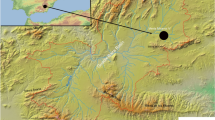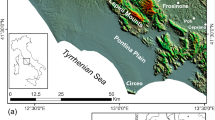Abstract
Since 1999, the Dikika Research Project (DRP; initiated by Z.A.) has conducted surveys and excavations in badlands that expose Pliocene and Pleistocene sediments south of the Awash River in Ethiopia, between surrounding hominin localities at Hadar1, Gona2 and the Middle Awash region3. Here we report our geological mapping and stratigraphic measurement of the DRP area, and the context of a remarkably well-preserved skeleton of the earliest known juvenile hominin at the Dikika DIK-1 locality4. Our mapping of the DRP area permits a complete definition of the hominin-bearing Hadar Formation and provides a cohesive structural and tectonic framework defining its relationships to adjacent strata. Our findings reveal the basin-scale tectonic, depositional and palaeoenvironmental history of the area, as well as a clear taphonomic and palaeontological context for the juvenile hominin. Such data are crucial for understanding the environmental context of human evolution5,6, and can be integrated into larger-scale tectonic and palaeoenvironmental studies7,8. Our basin-scale approach to palaeoenvironments provides a means to elucidate the complex geological history occurring at the scale of temporally and geographically controlled fossil point localities3,9,10,11, which occur within the rich tectonic and depositional history of the Awash Valley.
This is a preview of subscription content, access via your institution
Access options
Subscribe to this journal
Receive 51 print issues and online access
$199.00 per year
only $3.90 per issue
Buy this article
- Purchase on Springer Link
- Instant access to full article PDF
Prices may be subject to local taxes which are calculated during checkout


Similar content being viewed by others
References
Taieb, M., Johanson, D. C., Coppens, Y. & Aronson, J. L. Geological and palaeontological background of Hadar hominid site, Afar, Ethiopia. Nature 260, 289–293 (1976)
Quade, J. et al. Paleoenvironments of the earliest stone toolmakers, Gona, Ethiopia. Geol. Soc. Am. Bull. 116, 1529–1544 (2004)
White, T. D. et al. New discoveries of Australopithecus at Maka in Ethiopia. Nature 366, 261–265 (1993)
Alemseged, Z. et al. A juvenile early hominin skeleton from Dikika, Ethiopia. Nature doi:10.1038/nature05047 (this issue)
Behrensmeyer, A. K. Climate change and human evolution. Science 311, 476–478 (2006)
Feibel, C. S. Debating the environmental factors in hominid evolution. GSA Today 7, 1–7 (1997)
Beyene, A. & Abdelsalam, M. Tectonics of the Afar Depression: a review and synthesis. J. Afr. Earth Sci 41, 41–59 (2005)
Wolfendon, E., Ebinger, C., Yirgu, G., Deino, A. & Ayelew, D. Evolution of the northern Main Ethiopian rift: birth of a triple junction. Earth Planet. Sci. Lett. 224, 213–228 (2004)
White, T. et al. Asa Issie, Aramis and the origin of Australopithecus. Nature 440, 883–889 (2006)
WoldeGabriel, G., White, T. D., Suwa, G., Renne, P. & de Heinzelin, J. Ecological and temporal placement of early Pliocene hominids at Aramis, Ethiopia. Nature 371, 330–333 (1994)
WoldeGabriel, G. et al. Geology and palaeontology of the Late Miocene Middle Awash valley, Afar rift, Ethiopia. Nature 412, 175–178 (2001)
Kalb, J. E., Oswald, E. B., Mebrate, A., Tebedge, S. & Jolly, C. J. Stratigraphy of the Awash Group, Middle Awash Valley, Afar, Ethiopia. Newsl. Stratigr. 11, 95–127 (1982)
Haileab, B. & Brown, F. H. Turkana Basin–Middle Awash Valley correlations and the age of the Sagantole and Hadar Formations. J. Hum. Evol. 22, 453–468 (1992)
Todd, N. E. in The World of Elephants: Proc. 1st Int. Cong. (eds Caveratta, G., Gioia, P., Mussi, M. & Palombo, M. R.) 693–697 (Consiglio Nazionale delle Ricerche, Roma, 2001)
Bernor, R. L. & Armour-Chelu, M. in Neogene Paleontology of the Manonga Valley, Tanzania (ed. Harrison, T.) 219–264 (Plenum, New York, 1997)
Boisserie, J.-R. & White, T. D. new species of Pliocene Hippopotamidae from the Middle Awash, Ethiopia. J. Vertebr. Paleontol. 24, 474–480 (2004)
Cooke, H. B. S. Pliocene–Pleistocene Suidae from Hadar, Ethiopia. Kirtlandia 29, 1–63 (1978)
Gentry, A. W. Notes on Bovidae (Mammalia) from the Hadar Formation and from Amado and Geraru, Ethiopia. Kirtlandia 33, 1–30 (1981)
Gentry, A. W. in Les faunes plio-pléistocènes de la basse vallée de l'Omo (Ethiopie), I: Périssodactyles-Artiodactyles (Bovidae) (eds Coppens, Y. & Howell, F. C.) 119–191 (CNRS, Paris, 1985)
Harris, J. M. in Lothagam: the Dawn of Humanity in Eastern Africa (eds Leakey, M. G. & Harris, J. M.) 531–579 (Columbia, New York, 2003)
Vrba, E. S. New fossils of Alcelaphini and Caprinae (Bovidae: Mammalia) from Awash, Ethiopia, and phylogenetic analysis of Alcelaphini. Paleont. Afr. 34, 127–198 (1997)
Sabatier, M. Les rongeurs du site Pliocène à Hominidés de Hadar (Ethiopie). Palaeovertebrata 12, 1–56 (1982)
Levin, N., Quade, J., Simpson, S. W., Semaw, S. & Rogers, M. Isotopic evidence for Plio-Pleistocene environmental change at Gona, Ethiopia. Earth Planet. Sci. Lett. 219, 93–110 (2004)
Haile-Selassie, Y. et al. Mio-Pliocene mammals from the Middle Awash, Ethiopia. Geobios. 37, 536–552 (2004)
Leakey, M. G., Feibel, C. S., McDougall, I. & Walker, A. New four-million-year-old hominid species from Kanapoi and Allia Bay, Kenya. Nature 376, 565–571 (1995)
Leakey, M. G. et al. New hominin genus from eastern Africa shows diverse middle Pliocene lineages. Nature 410, 433–440 (2001)
Taieb, M., Coppens, Y., Johanson, D. C. & Kalb, J. Dépôts sédimentaires et faunes du Plio-Pléistocène de la basse vallée de l'Awash (Afar central, Ethiopie). C.R. Acad. Sci. D 275, 819–882 (1972)
Brown, F. H. & Cerling, T. E. Stratigraphical significance of the Tulu Bor Tuff of the Koobi Fora Formation. Nature 299, 212–215 (1982)
Walter, R. C. Age of Lucy and the first family: Laser 40Ar/39Ar dating of the Denen Dora Member of the Hadar Formation. Geology 22, 6–10 (1994)
Kimbel, W. H. et al. Late Pliocene Homo and Oldowan stone tools from the Hadar Formation (Kada Hadar Member), Ethiopia. J. Hum. Evol. 31, 549–561 (1996)
Acknowledgements
We thank J. Haile-Mariam of the Authority for Research and Conservation of Cultural Heritage, and the Afar Regional State for research permission; and G. Assefa and H. Habtemichael for aid in the field. This work would not be possible without the assistance of the many Issa field crew, as well as logistical support from M. Mekonnen, H. Defar, A. Zerihun, A. Takele, A. Kiros. We also thank J.-C. Rage for snake identification, and K. Reed and G. Eck for access to the Hadar catalogue and collections. This research was funded by the National Geographic Society with logistical support from the Institute for Human Origins and the Ministère des Affaires Etrangères. Stable isotope analyses were performed at RSES, Australian National University, Canberra and at FEEA Stable Isotope Laboratory, St. Andrews. Tephrostratigraphic chemical analyses were performed at the University of Oregon Microprobe Laboratory, Eugene, with funds from the Baldwin Memorial Fund. Author Contributions J.G.W. was the project geologist. D.C.R. did tephrostratigraphy. Fauna were analysed by Z.A. (head of project and palaeoanthropology), R.B. (palaeoenvironments), D.G. (biostratigraphy) and D.R. (micromammals).
Author information
Authors and Affiliations
Corresponding author
Ethics declarations
Competing interests
Reprints and permissions information is available at www.nature.com/reprints. The authors declare no competing financial interests.
Supplementary information
Supplementary Table 1
This Supplementary Table presents average chemical analyses of correlated Hadar Formation tephras from the Dikika area. Analyses have been normalized to total 100%. EPMA analyses were done at 10-12 keV and 5 nA, using a 5-10 μm beam. Section names correspond to those in Figure 2. (XLS 20 kb)
Rights and permissions
About this article
Cite this article
Wynn, J., Alemseged, Z., Bobe, R. et al. Geological and palaeontological context of a Pliocene juvenile hominin at Dikika, Ethiopia. Nature 443, 332–336 (2006). https://doi.org/10.1038/nature05048
Received:
Accepted:
Issue Date:
DOI: https://doi.org/10.1038/nature05048
This article is cited by
-
Calcium isotopic ecology of Turkana Basin hominins
Nature Communications (2020)
-
Fossil Giraffidae (Mammalia, Artiodactyla) from Lee Adoyta, Ledi-Geraru, and Late Pliocene Dietary Evolution in Giraffids from the Lower Awash Valley, Ethiopia
Journal of Mammalian Evolution (2017)
-
3.3-million-year-old stone tools from Lomekwi 3, West Turkana, Kenya
Nature (2015)
Comments
By submitting a comment you agree to abide by our Terms and Community Guidelines. If you find something abusive or that does not comply with our terms or guidelines please flag it as inappropriate.



